2024年福建省中考英语二轮 题型五 短文填空 复习课件(共32张PPT)
文档属性
| 名称 | 2024年福建省中考英语二轮 题型五 短文填空 复习课件(共32张PPT) |  | |
| 格式 | pptx | ||
| 文件大小 | 882.8KB | ||
| 资源类型 | 教案 | ||
| 版本资源 | 通用版 | ||
| 科目 | 英语 | ||
| 更新时间 | 2024-03-18 19:27:38 | ||
图片预览


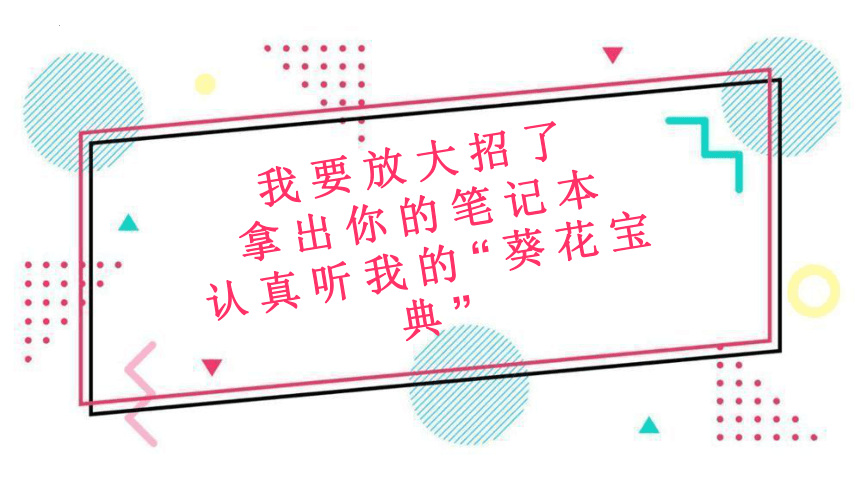

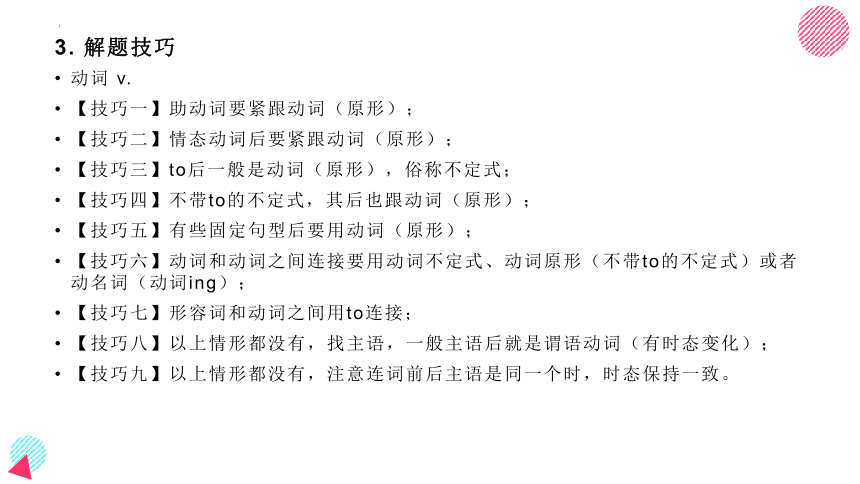
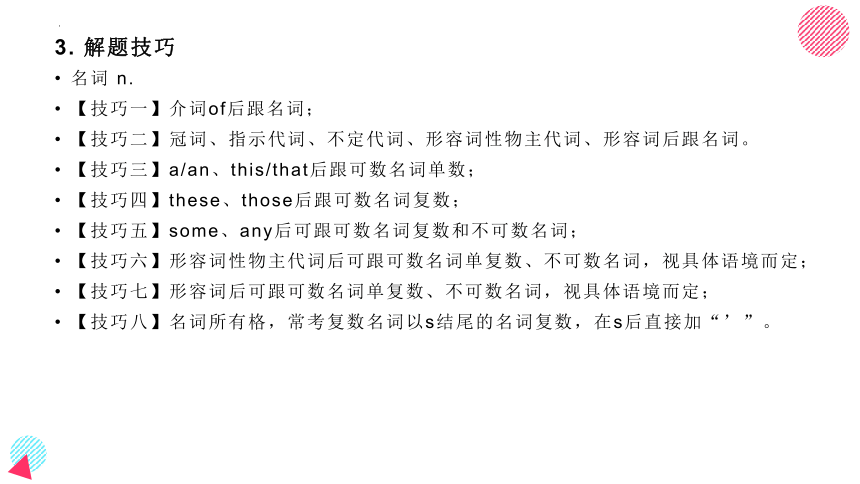
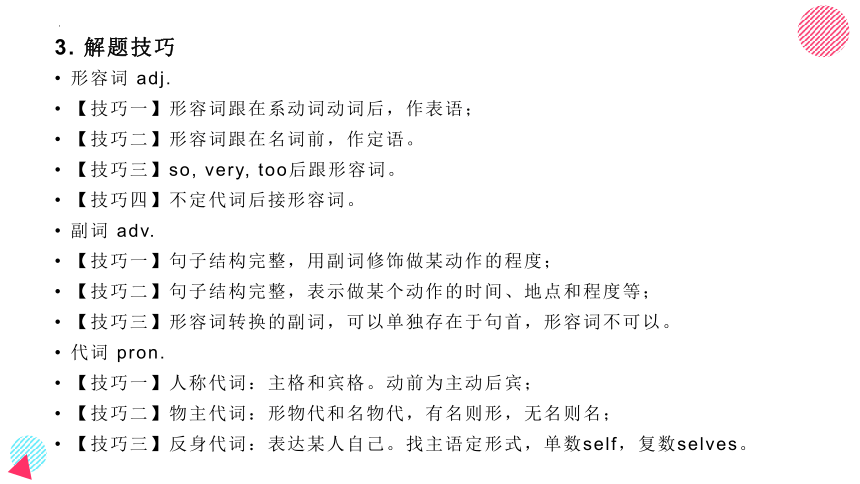

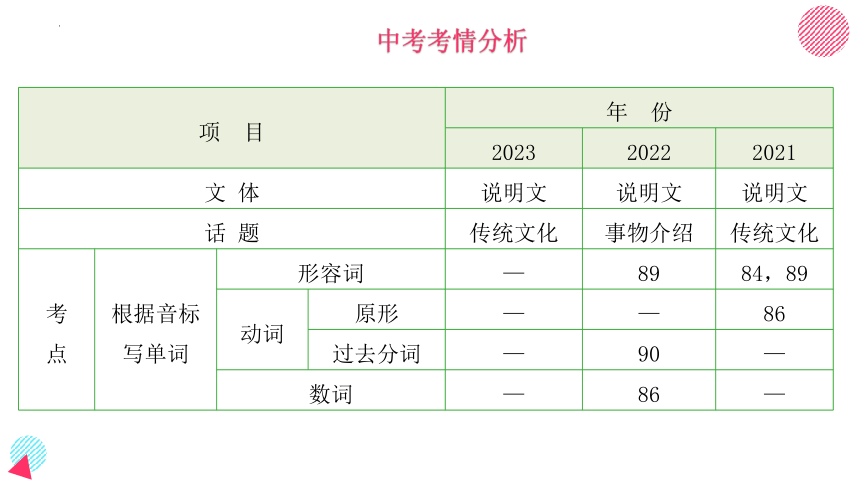
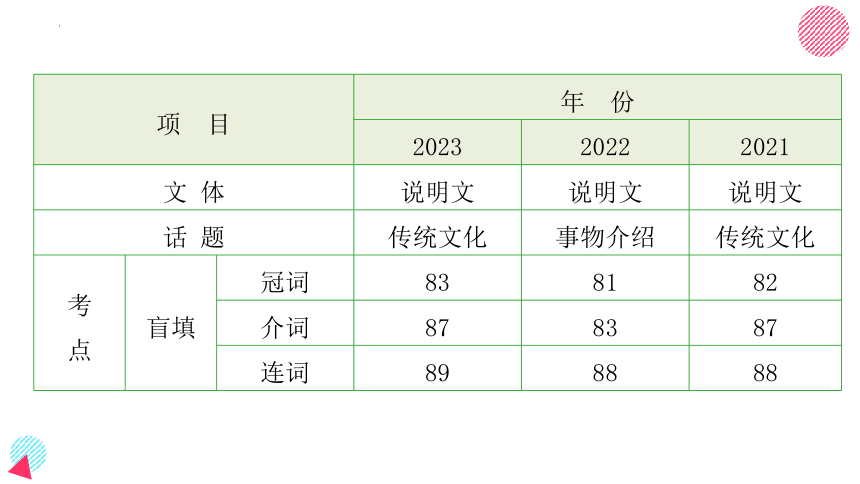
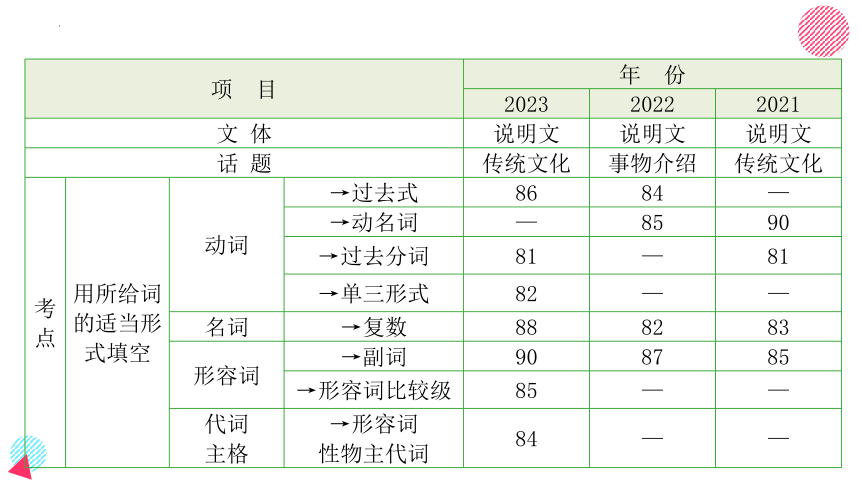
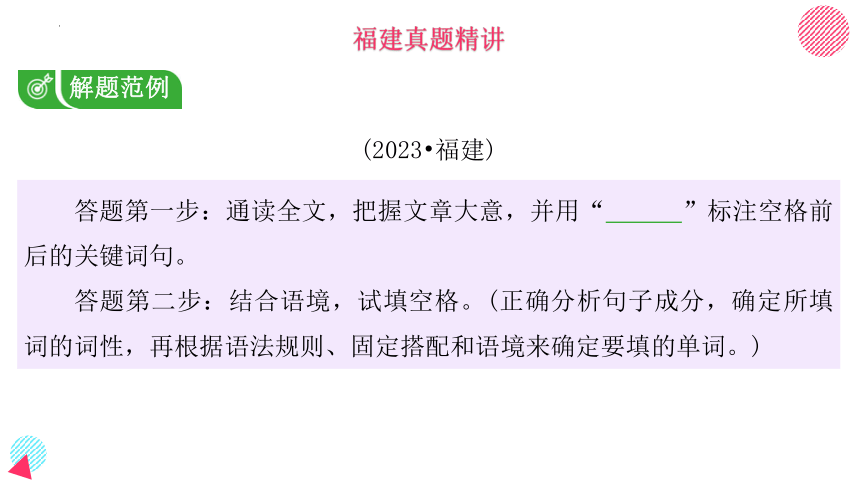
文档简介
(共32张PPT)
2024福建中考英语重难题型攻关
题型五 短文填空
我要放大招了
拿出你的笔记本
认真听我的“葵花宝典”
选词填空答题技巧
1. 常考点
一般考查10个单词的词汇运用能力,分别为动词v(谓语动词和非谓语动词)、名词n(单复数和所有格)、形容词adj、副词adv(三级变化,以及形变副)、数词num.(基与序)、介词prep(本身含义要牢记)、连词conj(连词,连短,连句子)、代词pron(五形变化)等,有些题目根据文章给出符合文章的词性,不需要变形,但是有些题目只给出单词,需要依据文意变形,难度加大。
2. 解题步骤
(1)译词义,注词性;
(2)空前空后定词性,缩小范围,找合理;
(3)词性定准,变词形。
3. 解题技巧
动词 v.
【技巧一】助动词要紧跟动词(原形);
【技巧二】情态动词后要紧跟动词(原形);
【技巧三】to后一般是动词(原形),俗称不定式;
【技巧四】不带to的不定式,其后也跟动词(原形);
【技巧五】有些固定句型后要用动词(原形);
【技巧六】动词和动词之间连接要用动词不定式、动词原形(不带to的不定式)或者动名词(动词ing);
【技巧七】形容词和动词之间用to连接;
【技巧八】以上情形都没有,找主语,一般主语后就是谓语动词(有时态变化);
【技巧九】以上情形都没有,注意连词前后主语是同一个时,时态保持一致。
3. 解题技巧
名词 n.
【技巧一】介词of后跟名词;
【技巧二】冠词、指示代词、不定代词、形容词性物主代词、形容词后跟名词。
【技巧三】a/an、this/that后跟可数名词单数;
【技巧四】these、those后跟可数名词复数;
【技巧五】some、any后可跟可数名词复数和不可数名词;
【技巧六】形容词性物主代词后可跟可数名词单复数、不可数名词,视具体语境而定;
【技巧七】形容词后可跟可数名词单复数、不可数名词,视具体语境而定;
【技巧八】名词所有格,常考复数名词以s结尾的名词复数,在s后直接加“’”。
3. 解题技巧
形容词 adj.
【技巧一】形容词跟在系动词动词后,作表语;
【技巧二】形容词跟在名词前,作定语。
【技巧三】so, very, too后跟形容词。
【技巧四】不定代词后接形容词。
副词 adv.
【技巧一】句子结构完整,用副词修饰做某动作的程度;
【技巧二】句子结构完整,表示做某个动作的时间、地点和程度等;
【技巧三】形容词转换的副词,可以单独存在于句首,形容词不可以。
代词 pron.
【技巧一】人称代词:主格和宾格。动前为主动后宾;
【技巧二】物主代词:形物代和名物代,有名则形,无名则名;
【技巧三】反身代词:表达某人自己。找主语定形式,单数self,复数selves。
3. 解题技巧
数词 num.
【技巧一】与可数名词连用表示数量;
【技巧二】表示“第几个……”用序数词,一般后面跟第几个月份“month”、年“year”、生日(birthday)、天(day)等。
【技巧三】考核基与序。
介词 prep.
【技巧一】介绍前后两词之间的关系;
【技巧二】基本含义记心间。
连词 conj.
【技巧一】连接单词和单词,词性保持一致;
【技巧二】连接短语和短语,结构保持一致;
【技巧三】连接句子和句子,前后时态保持一致。
中考考情分析
项 目 年 份 2023 2022 2021
文 体 说明文 说明文 说明文
话 题 传统文化 事物介绍 传统文化
考 点 根据音标 写单词 形容词 — 89 84,89
动词 原形 — — 86
过去分词 — 90 —
数词 — 86 —
项 目 年 份 2023 2022 2021
文 体 说明文 说明文 说明文
话 题 传统文化 事物介绍 传统文化
考 点 盲填 冠词 83 81 82
介词 87 83 87
连词 89 88 88
项 目 年 份 2023 2022 2021
文 体 说明文 说明文 说明文
话 题 传统文化 事物介绍 传统文化
考 点 用所给词 的适当形 式填空 动词 →过去式 86 84 —
→动名词 — 85 90
→过去分词 81 — 81
→单三形式 82 — —
名词 →复数 88 82 83
形容词 →副词 90 87 85
→形容词比较级 85 — —
代词 主格 →形容词 性物主代词 84 — —
福建真题精讲
(2023 福建)
解题范例
答题第一步:通读全文,把握文章大意,并用“ ”标注空格前后的关键词句。
答题第二步:结合语境,试填空格。(正确分析句子成分,确定所填词的词性,再根据语法规则、固定搭配和语境来确定要填的单词。)
Niejiazhuang Village in Weifang is
famous for colored clay sculpture handicraft
(泥塑手工艺), which dates back to the Ming
Dynasty. The Weifang government has 1 (encourage) local
↓
语法分析:分析句子成分可知,此处应用动词的过去分词与“has”构成现在完成时。
people to learn traditional handicraft and make more money to get rid of poverty(脱贫).
【段意概括】
第一段:潍坊的聂家庄以其可追溯到明代的泥塑手工艺品而闻名。这项技术得到了当地政府的关注和大力支持。
Nie Peng 2 (be) a young villager in Niejiazhuang. He is
↓
语法分析:句子主语为第三人称单数,由下文可知时态为一般现在时,应用is。
crazy about clay sculpture handicraft. He began learning it from his father when he was 3 child. He has led lots of young
↓
语法分析:分析句子成分可知,空格处修饰单数名词“child”表“一个”,应用不定冠词a。
第二段:作为当地的一名年轻村民,聂鹏非常热爱泥塑工艺并且带领村里和附近的许多年轻工匠制作彩色泥塑。这种手工艺已成为当地人变得比以前更富有的重要途径。
craftsmen(手艺人) in and near 4 (he) village to make colored
↓
语法分析:空格处修饰名词“village”,应用形容词性物主代词。
clay sculptures and the handicraft has become an important way for local people to get 5 (rich) than before.
↓
语法分析:由句意及空后的“than”可知,此处应用形容词“rich”的比较级。
The tiger is a typical subject for colored clay sculptures. Nie 6 (start) to learn to make clay tigers in 2010, the Year
↓
语法分析:由时间状语“in 2010”可知,此处应用动词的过去式。
第三段:老虎是典型的彩泥塑题材。2010年虎年,聂鹏开始学习制作泥虎并且见证了这种艺术形式的发展。
of the Tiger. Over these years, he has seen the development of the art form. 7 first, the clay tigers were all of the same
↓
固定搭配:at first“起初,起先”,为固定搭配。注意句首单词首字母需大写。
small size. Now there are tigers of different 8 (size) and
↓
语法分析:“different”修饰可数名词复数。
the largest can be over two meters tall. The tigers used to be colored pink and green, but now have become more colorful.
第四段:聂鹏对泥塑手工艺未来发展的希冀。
Today Nie cares for the future of clay sculpture handicraft 9 encourages young craftsmen to create more
↓
语法分析:空格处连接“cares for”和“encourages”两个动作,表示递进关系,应用并列连词and。
works. He 10 (real) hopes that the sculpture handicraft will
↓
语法分析:空格处修饰动词“hopes”,应用副词。
be passed down to the next generation.
答题第三步:查漏补缺,对于还未填出的题,综合全文推断出答案。
答题第四步:复读全文,检查答案。(从时态、语态、逻辑关系及单词拼写等方面进行检查,最后确定答案。)
【答案速查】1.encouraged 2.is 3.a 4.his 5.richer 6.started 7.At 8.sizes 9.and 10.really
答题第五步:核对答案,反思错题。
重难题型精练
阅读下面短文,根据语境或所给单词的提示,在每个空格内填入一个恰当的词,要求所填的词意义准确、形式正确,使短文意思完整、行文连贯。
Text 1
人与社会——世界主要国家的文化习俗与文化景观
Putting lion statues outside of buildings is quite common in China. It was especially common in ancient times. They could be 1.______(see) at the gates of temples, government offices and the homes of wealthy people. The statues are 2._________(usual) made of stone. People believe they can scare away evil(邪恶的) spirits and bring good luck.
seen
usually
However, the lion is not a native of China. It was not until about 2,000 years ago, when lions were given to Chinese emperors as 3._______(gift), that the animal could be seen in China. Emperors loved lions 4._________ they looked strong. They 5.______ (keep) lions as pets and as a symbol of power. The animals were also believed to look like Suan Ni(狻猊), one of 6._____ nine legendary sons of the dragon.
gifts
because
kept
the
As Buddhism(佛教) was introduced to the country later, 7.______(many) Chinese people came to know lions. Buddhas ride lions and the lion's roar(咆哮) was said to be the teachings of the Buddhas.
Since ancient times, people have put lion statues outside their houses to protect their families. They usually put a pair of stone lions on each side of the gate to 8._______(they) home. A male lion 9.________(stand) on the left playing with a ball. A female lion is on the right with a baby lion under her paw. She stands 10._____ a large and thriving(兴旺的) family.
more
their
stands
for
【文章大意】本文是一篇说明文。主要介绍了中国雄伟建筑的门口都有石狮子。并且介绍了它们的起源以及它们所代表的含义。
Text 2
人与社会——文学作品
The Art of War (Sun Tzu bingfa) is a military (军事的) book written by the Chinese strategist Sun Tzu (personal name: Sun Wu). The book is 1._____ earliest known one on war and military science.
It is divided 2.______ 13 chapters. And the aim is to advise generals on how to prepare, attack, defend(防御) and more.
the
into
It is hard to know exactly when The Art of War was written, 3._____ most experts think it was written during the Spring and Autumn Period. Experts also cannot be sure about the details of the life of 4._____(it) author, Sun Tzu, but they believe he was a general working for the State of Wu. It is clear that whatever Sun Tzu's life 5._____________(experience) were, he had a wealth of knowledge about war and strategy(策略).
but
its
experiences
The premise(前提) of The Art of War is that war should be avoided with diplomacy(外交). If it cannot be avoided, it should be fought 6.________(wise) to reduce damage and the waste of resources. War should only be the last method.
wisely
The Art of War stresses preparation for battle above all, including having 7._______(luck) weather conditions, geographic advantages and the unity of the people, 8.__________(study) the enemy's movements and weaknesses and training soldiers. At the same time, the book also 9.__________(suggest) that military strategy should be changed to suit new conditions, depending on the actual situation on the battlefield.
lucky
studying
suggests
The Art of War has been very popular since it was first published, influencing leaders all over the world. Besides military strategy, the methods mentioned in the book have now 10._______(find) practical use in many competitive fields, such as business and sports.
【文章大意】本文是一篇说明文。文章主要介绍了《孙子兵法》的相关信息。
found
2024福建中考英语重难题型攻关
题型五 短文填空
我要放大招了
拿出你的笔记本
认真听我的“葵花宝典”
选词填空答题技巧
1. 常考点
一般考查10个单词的词汇运用能力,分别为动词v(谓语动词和非谓语动词)、名词n(单复数和所有格)、形容词adj、副词adv(三级变化,以及形变副)、数词num.(基与序)、介词prep(本身含义要牢记)、连词conj(连词,连短,连句子)、代词pron(五形变化)等,有些题目根据文章给出符合文章的词性,不需要变形,但是有些题目只给出单词,需要依据文意变形,难度加大。
2. 解题步骤
(1)译词义,注词性;
(2)空前空后定词性,缩小范围,找合理;
(3)词性定准,变词形。
3. 解题技巧
动词 v.
【技巧一】助动词要紧跟动词(原形);
【技巧二】情态动词后要紧跟动词(原形);
【技巧三】to后一般是动词(原形),俗称不定式;
【技巧四】不带to的不定式,其后也跟动词(原形);
【技巧五】有些固定句型后要用动词(原形);
【技巧六】动词和动词之间连接要用动词不定式、动词原形(不带to的不定式)或者动名词(动词ing);
【技巧七】形容词和动词之间用to连接;
【技巧八】以上情形都没有,找主语,一般主语后就是谓语动词(有时态变化);
【技巧九】以上情形都没有,注意连词前后主语是同一个时,时态保持一致。
3. 解题技巧
名词 n.
【技巧一】介词of后跟名词;
【技巧二】冠词、指示代词、不定代词、形容词性物主代词、形容词后跟名词。
【技巧三】a/an、this/that后跟可数名词单数;
【技巧四】these、those后跟可数名词复数;
【技巧五】some、any后可跟可数名词复数和不可数名词;
【技巧六】形容词性物主代词后可跟可数名词单复数、不可数名词,视具体语境而定;
【技巧七】形容词后可跟可数名词单复数、不可数名词,视具体语境而定;
【技巧八】名词所有格,常考复数名词以s结尾的名词复数,在s后直接加“’”。
3. 解题技巧
形容词 adj.
【技巧一】形容词跟在系动词动词后,作表语;
【技巧二】形容词跟在名词前,作定语。
【技巧三】so, very, too后跟形容词。
【技巧四】不定代词后接形容词。
副词 adv.
【技巧一】句子结构完整,用副词修饰做某动作的程度;
【技巧二】句子结构完整,表示做某个动作的时间、地点和程度等;
【技巧三】形容词转换的副词,可以单独存在于句首,形容词不可以。
代词 pron.
【技巧一】人称代词:主格和宾格。动前为主动后宾;
【技巧二】物主代词:形物代和名物代,有名则形,无名则名;
【技巧三】反身代词:表达某人自己。找主语定形式,单数self,复数selves。
3. 解题技巧
数词 num.
【技巧一】与可数名词连用表示数量;
【技巧二】表示“第几个……”用序数词,一般后面跟第几个月份“month”、年“year”、生日(birthday)、天(day)等。
【技巧三】考核基与序。
介词 prep.
【技巧一】介绍前后两词之间的关系;
【技巧二】基本含义记心间。
连词 conj.
【技巧一】连接单词和单词,词性保持一致;
【技巧二】连接短语和短语,结构保持一致;
【技巧三】连接句子和句子,前后时态保持一致。
中考考情分析
项 目 年 份 2023 2022 2021
文 体 说明文 说明文 说明文
话 题 传统文化 事物介绍 传统文化
考 点 根据音标 写单词 形容词 — 89 84,89
动词 原形 — — 86
过去分词 — 90 —
数词 — 86 —
项 目 年 份 2023 2022 2021
文 体 说明文 说明文 说明文
话 题 传统文化 事物介绍 传统文化
考 点 盲填 冠词 83 81 82
介词 87 83 87
连词 89 88 88
项 目 年 份 2023 2022 2021
文 体 说明文 说明文 说明文
话 题 传统文化 事物介绍 传统文化
考 点 用所给词 的适当形 式填空 动词 →过去式 86 84 —
→动名词 — 85 90
→过去分词 81 — 81
→单三形式 82 — —
名词 →复数 88 82 83
形容词 →副词 90 87 85
→形容词比较级 85 — —
代词 主格 →形容词 性物主代词 84 — —
福建真题精讲
(2023 福建)
解题范例
答题第一步:通读全文,把握文章大意,并用“ ”标注空格前后的关键词句。
答题第二步:结合语境,试填空格。(正确分析句子成分,确定所填词的词性,再根据语法规则、固定搭配和语境来确定要填的单词。)
Niejiazhuang Village in Weifang is
famous for colored clay sculpture handicraft
(泥塑手工艺), which dates back to the Ming
Dynasty. The Weifang government has 1 (encourage) local
↓
语法分析:分析句子成分可知,此处应用动词的过去分词与“has”构成现在完成时。
people to learn traditional handicraft and make more money to get rid of poverty(脱贫).
【段意概括】
第一段:潍坊的聂家庄以其可追溯到明代的泥塑手工艺品而闻名。这项技术得到了当地政府的关注和大力支持。
Nie Peng 2 (be) a young villager in Niejiazhuang. He is
↓
语法分析:句子主语为第三人称单数,由下文可知时态为一般现在时,应用is。
crazy about clay sculpture handicraft. He began learning it from his father when he was 3 child. He has led lots of young
↓
语法分析:分析句子成分可知,空格处修饰单数名词“child”表“一个”,应用不定冠词a。
第二段:作为当地的一名年轻村民,聂鹏非常热爱泥塑工艺并且带领村里和附近的许多年轻工匠制作彩色泥塑。这种手工艺已成为当地人变得比以前更富有的重要途径。
craftsmen(手艺人) in and near 4 (he) village to make colored
↓
语法分析:空格处修饰名词“village”,应用形容词性物主代词。
clay sculptures and the handicraft has become an important way for local people to get 5 (rich) than before.
↓
语法分析:由句意及空后的“than”可知,此处应用形容词“rich”的比较级。
The tiger is a typical subject for colored clay sculptures. Nie 6 (start) to learn to make clay tigers in 2010, the Year
↓
语法分析:由时间状语“in 2010”可知,此处应用动词的过去式。
第三段:老虎是典型的彩泥塑题材。2010年虎年,聂鹏开始学习制作泥虎并且见证了这种艺术形式的发展。
of the Tiger. Over these years, he has seen the development of the art form. 7 first, the clay tigers were all of the same
↓
固定搭配:at first“起初,起先”,为固定搭配。注意句首单词首字母需大写。
small size. Now there are tigers of different 8 (size) and
↓
语法分析:“different”修饰可数名词复数。
the largest can be over two meters tall. The tigers used to be colored pink and green, but now have become more colorful.
第四段:聂鹏对泥塑手工艺未来发展的希冀。
Today Nie cares for the future of clay sculpture handicraft 9 encourages young craftsmen to create more
↓
语法分析:空格处连接“cares for”和“encourages”两个动作,表示递进关系,应用并列连词and。
works. He 10 (real) hopes that the sculpture handicraft will
↓
语法分析:空格处修饰动词“hopes”,应用副词。
be passed down to the next generation.
答题第三步:查漏补缺,对于还未填出的题,综合全文推断出答案。
答题第四步:复读全文,检查答案。(从时态、语态、逻辑关系及单词拼写等方面进行检查,最后确定答案。)
【答案速查】1.encouraged 2.is 3.a 4.his 5.richer 6.started 7.At 8.sizes 9.and 10.really
答题第五步:核对答案,反思错题。
重难题型精练
阅读下面短文,根据语境或所给单词的提示,在每个空格内填入一个恰当的词,要求所填的词意义准确、形式正确,使短文意思完整、行文连贯。
Text 1
人与社会——世界主要国家的文化习俗与文化景观
Putting lion statues outside of buildings is quite common in China. It was especially common in ancient times. They could be 1.______(see) at the gates of temples, government offices and the homes of wealthy people. The statues are 2._________(usual) made of stone. People believe they can scare away evil(邪恶的) spirits and bring good luck.
seen
usually
However, the lion is not a native of China. It was not until about 2,000 years ago, when lions were given to Chinese emperors as 3._______(gift), that the animal could be seen in China. Emperors loved lions 4._________ they looked strong. They 5.______ (keep) lions as pets and as a symbol of power. The animals were also believed to look like Suan Ni(狻猊), one of 6._____ nine legendary sons of the dragon.
gifts
because
kept
the
As Buddhism(佛教) was introduced to the country later, 7.______(many) Chinese people came to know lions. Buddhas ride lions and the lion's roar(咆哮) was said to be the teachings of the Buddhas.
Since ancient times, people have put lion statues outside their houses to protect their families. They usually put a pair of stone lions on each side of the gate to 8._______(they) home. A male lion 9.________(stand) on the left playing with a ball. A female lion is on the right with a baby lion under her paw. She stands 10._____ a large and thriving(兴旺的) family.
more
their
stands
for
【文章大意】本文是一篇说明文。主要介绍了中国雄伟建筑的门口都有石狮子。并且介绍了它们的起源以及它们所代表的含义。
Text 2
人与社会——文学作品
The Art of War (Sun Tzu bingfa) is a military (军事的) book written by the Chinese strategist Sun Tzu (personal name: Sun Wu). The book is 1._____ earliest known one on war and military science.
It is divided 2.______ 13 chapters. And the aim is to advise generals on how to prepare, attack, defend(防御) and more.
the
into
It is hard to know exactly when The Art of War was written, 3._____ most experts think it was written during the Spring and Autumn Period. Experts also cannot be sure about the details of the life of 4._____(it) author, Sun Tzu, but they believe he was a general working for the State of Wu. It is clear that whatever Sun Tzu's life 5._____________(experience) were, he had a wealth of knowledge about war and strategy(策略).
but
its
experiences
The premise(前提) of The Art of War is that war should be avoided with diplomacy(外交). If it cannot be avoided, it should be fought 6.________(wise) to reduce damage and the waste of resources. War should only be the last method.
wisely
The Art of War stresses preparation for battle above all, including having 7._______(luck) weather conditions, geographic advantages and the unity of the people, 8.__________(study) the enemy's movements and weaknesses and training soldiers. At the same time, the book also 9.__________(suggest) that military strategy should be changed to suit new conditions, depending on the actual situation on the battlefield.
lucky
studying
suggests
The Art of War has been very popular since it was first published, influencing leaders all over the world. Besides military strategy, the methods mentioned in the book have now 10._______(find) practical use in many competitive fields, such as business and sports.
【文章大意】本文是一篇说明文。文章主要介绍了《孙子兵法》的相关信息。
found
同课章节目录
- 词法
- 名词
- 动词和动词短语
- 动词语态
- 动词时态
- 助动词和情态动词
- 非谓语动词
- 冠词
- 代词
- 数词和量词
- 形容词副词及其比较等级
- 介词和介词短语
- 连词和感叹词
- 构词法
- 相似、相近词比较
- 句法
- 陈述句
- 一般疑问句和否定疑问句
- 特殊疑问句及选择疑问句
- 反意疑问句
- 存在句(There be句型)
- 宾语从句
- 定语从句
- 状语从句
- 主谓一致问题
- 简单句
- 并列句
- 复合句
- 主谓一致
- 主、表语从句
- 名词性从句
- 直接引语和间接引语
- 虚拟语气
- 感叹句
- 强调句
- 倒装句
- 祈使句
- 句子的成分
- 句子的分类
- 题型专区
- 单项选择部分
- 易错题
- 完形填空
- 阅读理解
- 词汇练习
- 听说训练
- 句型转换
- 补全对话
- 短文改错
- 翻译
- 书面表达
- 任务型阅读
- 语法填空
- 其他资料
